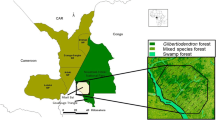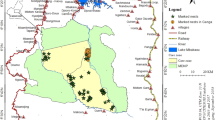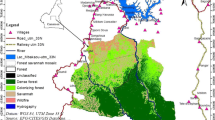Abstract
Accurate and precise surveys of primate abundance provide the basis for understanding species ecology and essential information for conservation assessments. Owing to the elusive nature of wild apes and the vast region of dense forest they inhabit, population estimates of central chimpanzees (Pan troglodytes troglodytes) and western lowland gorillas (Gorilla gorilla gorilla) have largely relied on surveys of their nests. Specific information about the nesting behavior of apes permits the estimation of the number of nests built (nest creation rate). Similarly, information on nest characteristics and environmental factors can be used to estimate the time it takes nests to decay (nest decay rate). Nest creation and decay rates are then used to convert nest density estimates to absolute ape densities. Population estimates that use site-specific estimates of nest creation and decay rates are more accurate and precise. However, it is common practice to generalize these conversion factors across sites because of the additional cost of studies required to gather the information to estimate them. Over a 9-mo study period, we detected and monitored the time to decay of gorilla nests (N = 514) and chimpanzee nests (N = 521) in northern Republic of Congo. We investigated the influence of nest characteristics and environmental factors on nest survivorship and estimated the mean time to nest decay (or equivalently survival) using MARK. Key factors influencing nest decay rate included ape species, forest type, nest height, mean rainfall, nest structure, nest type, and primary aspects of nest construction. Our findings highlight the synergistic effect of behavior and environment on great ape nest degradation, as well as providing practical insights for improving measures to monitor remaining populations of these endangered species.


Similar content being viewed by others
References
Ancrenaz, M., Calaque, R., & Lackman-Ancrenaz, I. (2004). Orangutan nesting behavior in disturbed forest of Sabah, Malaysia: Implications for nest census. International Journal of Primatology, 25(5), 983–1000.
Baldwin, P. J., Sabater Pi, J., McGrew, W. C., & Tutin, C. E. G. (1981). Comparisons of nests made by different populations of chimpanzees (Pan troglodytes). Primates, 22(4), 474–486.
Buckland, S. T., Anderson, D. R., Burnham, K. P., Laake, J. L., Borchers, D. L., & Thomas, L. (2001). Introduction to Distance sampling. London: Oxford University Press.
Burnham, K.P., & Anderson, D.R. (2002). Model selection and multimodel inference. Berlin: Springer.
Clark, C. J., Poulsen, J. R., Malonga, R., & Elkan, P. W. (2009). Logging concessions can extend the conservation estate for central African tropical forests. Conservation Biology, 23(5), 1281–1293.
Dinsmore, S. J., White, G. C., & Knopf, F. L. (2002). Advanced techniques for modeling avian nest survival. Ecology, 83, 3476–3488.
Dupain, J., Guislain, P., Nguenang, G. M., De Vleeschouwer, K., & Van Elsacker, L. (2004). High chimpanzee and gorilla densities in a non-protected area on the northern periphery of the Dja Faunal Reserve, Cameroon. Oryx, 38, 209–216.
Fruth, B., & Hohmann, G. (1993). Ecological and behavioral aspects of nest-building in wild bonobos (Pan paniscus). Ethology, 94(2), 113–126.
Fruth, B., & Hohmann, G. (1994). Nests: Living artefacts of recent apes? Current Anthropology, 35(3), 310–311.
Furuichi, T., Hashimoto, C., & Tashiro, Y. (2001). Extended application of a marked-nest census method to examine seasonal changes in habitat use by chimpanzees. International Journal of Primatology, 22, 913–928.
Ghiglieri, M. P. (1984). The chimpanzees of Kibale Forest. New York: Columbia University Press.
Gond, V., Fayolle, A., Pennec, A., Cornu, G., Mayaux, P., et al. (2013). Vegetation structure and greenness in Central Africa from Modis multi-temporal data. Philosophical Transactions of the Royal Society B-Biological Sciences, 368(1625), 1–8.
Goodall, J.M. (1962). Nest building behavior in the free ranging chimpanzee. Annals of the New York Academy of Sciences, 102(2), 455–467.
Hardus, M. E., Lameira, A. R., Menken, S. B. J., & Wich, S. A. (2012). Effects of logging on orangutan behavior. Biological Conservation, 146(1), 177–187.
Hashimoto, C. (1995). Population census of the chimpanzees in the Kalinzu Forest, Uganda: Comparison between methods with nest counts. Primates, 36(4), 477–488.
IUCN. (2014). Regional action plan for the conservation of western lowland gorillas and central chimpanzees 2015–2025. Gland: IUCN SSC Primate Specialist Group.
Junker, J., Blake, S., Boesch, C., Campbell, G., du Toit, L., et al. (2012). Recent decline in suitable environmental conditions for African great apes. Diversity and Distributions, 18(11), 1077–1091.
Kaplan, E. L., & Meier, P. (1958). Nonparametric estimation from incomplete observations. Journal of the American Statistical Association, 53(282), 457–481.
Koops, K., McGrew, W. C., de Vries, H., & Matsuzawa, T. (2012). Nest-building by chimpanzees (Pan troglodytes verus) at Seringbara, Nimba Mountains: Antipredation, thermoregulation, and antivector hypotheses. International Journal of Primatology, 33(2), 356–380.
Kouakou, C. Y., Boesch, C., & Kuehl, H. (2009). Estimating chimpanzee population size with nest counts: Validating methods in Tai National Park. American Journal of Primatology, 71(6), 447–457.
Laing, S. E., Buckland, S. T., Burn, R. W., Lambie, D., & Amphlett, A. (2003). Dung and nest surveys: Estimating decay rates. Journal of Applied Ecology, 40(6), 1102–1111.
Letouzey, R. (1985). Notice de la carte phytogéographique du Cameroun au 1:500000. Toulouse: Institut de la Carte Internationale de la Végétation.
Marchesi, P., Marchesi, N., Fruth, B., & Boesch, C. (1995). Census and distribution of chimpanzees in Cote D’Ivoire. Primates, 36, 591–607.
Mathewson, P. D., Spehar, S. N., Meijaard, E., Nardiyono, N., Purnomo, A., et al. (2008). Evaluating orangutan census techniques using nest decay rates: Implications for population estimates. Ecological Applications, 18(1), 208–221.
McClanahan, T. R. (1986). Quick population survey method using fecal droppings and a steady-state assumption. African Journal of Ecology, 24(1), 37–39.
Mehlman, P. T., & Doran, D. M. (2002). Influencing western gorilla nest construction at Mondika Research Center. International Journal of Primatology, 23(6), 1257–1285.
Meijaard, E., Albar, G., Nardiyono, N., Rayadin, Y., Ancrenaz, M., & Spehar, S. (2010). Unexpected ecological resilience in Bornean orangutans and implications for pulp and paper plantation management. PLoS ONE, 5(9), e12813. doi:10.1371/journal.pone.0012813.
Morgan, D., Sanz, C., Onononga, J. R., & Strindberg, S. (2006). Ape abundance and habitat use in the Goualougo Triangle, Republic of Congo. International Journal of Primatology, 27(1), 147–179.
Morrogh-Bernard, H. C., Husson, S. J., Knott, C. D., Wich, S. A., van Schaik, C. P., et al. (2009). Orangutan activity budgets and diet: A comparison between species, populations, and habitats. In S. A. Wich, S. S. Utami Atmoko, T. Mitra Setia, & C. P. van Schaik (Eds.), Orangutans: Geographic variation in behavioral ecology and conservation (pp. 119–133). Oxford: Oxford University Press.
Plumptre, A. J., & Reynolds, V. (1996). Censusing chimpanzees in the Budongo Forest, Uganda. International Journal of Primatology, 17(1), 85–99.
Plumptre, A. J., & Reynolds, V. (1997). Nesting behavior of chimpanzees: Implications for censuses. International Journal of Primatology, 18(4), 475–485.
Prasetyo, D., Ancrenaz, M., Morrogh-Bernard, H., Atmoko, S. S. U., Wich, S., & Van Schaik, C. (2009). Nest building in orangutans. In S. A. Wich, S. S. Utami Atmoko, T. Mitra Setia, & C. P. van Schaik (Eds.), Orangutans: Geographic variation in behavioral ecology and conservation (pp. 269–276). Oxford: Oxford University Press.
Pruetz, J. D., Fulton, S. J., Marchant, L. F., McGrew, W. C., Schiel, M., & Waller, M. (2008). Arboreal nesting as anti-predator adaptation by savanna chimpanzees (Pan troglodytes verus) in southeastern Senegal. American Journal of Primatology, 70(4), 393–401.
Rainey, H. J., Iyenguet, F. C., Malanda, G. A. F., Madzoke, B., Dos Santos, D., et al. (2010). Survey of Raphia swamp forest, Republic of Congo, indicates high densities of Critically Endangered western lowland gorillas Gorilla gorilla gorilla. Oryx, 44(1), 124–132.
Samson, D. R. (2012). The chimpanzee nest quantified: Morphology and ecology of arboreal sleeping platforms within the dry habitat site of Toro-Semliki Wildlife Reserve, Uganda. Primates, 53(4), 357–364.
Samson, D. R., & Hunt, K. D. (2012). A thermodynamic comparison of arboreal and terrestrial sleeping sites for dry-habitat chimpanzees (Pan troglodytes schweinfurthii) at the Toro-Semliki Wildlife Reserve, Uganda. American Journal of Primatology, 74(9), 811–818.
Samson, D. R., & Hunt, K. D. (2014). Chimpanzees preferentially select sleeping platform construction tree species with biomechanical properties that yield stable, firm, but compliant nests. PLoS ONE, 9(4), e95361. doi:10.1371/journal.pone.0095361.
Samson, D. R., Muehlenbein, M. P., & Hunt, K. D. (2013). Do chimpanzees (Pan troglodytes schweinfurthii) exhibit sleep related behaviors that minimize exposure to parasitic arthropods? A preliminary report on the possible anti-vector function of chimpanzee sleeping platforms. Primates, 54, 73–80.
Sanz, C., Morgan, D., Strindberg, S., & Onononga, J. R. (2007). Distinguishing between the nests of sympatric chimpanzees and gorillas. Journal of Applied Ecology, 44(2), 263–272.
Sept, J. M. (1992). Was there no place like home: A new perspective on early hominid archaeological sites from the mapping of chimpanzee nests. Current Anthropology, 33(2), 187–207.
Serckx, A., Huynen, M. C., Bastin, J. P., Hambuckers, A., Beudels-Jamar, R. C., et al. (2014). Nest grouping patterns of bonobos (Pan paniscus) in relation to fruit availability in a forest-savannah mosaic. PLoS ONE, 9(4), e93742. doi:10.1371/journal.pone.0093742.
Stewart, F. A. (2011). Why sleep in a nest? Empirical testing of the function of simple shelters made by wild chimpanzees. American Journal of Physical Anthropology, 146(2), 313–318.
Stewart, F. A., & Pruetz, J. D. (2013). Do chimpanzee nests serve an anti-predatory function? American Journal of Primatology, 75(6), 593–604.
Stewart, F. A., Piel, A. K., & McGrew, W. C. (2011). Living archaeology: Artefacts of specific nest site fidelity in wild chimpanzees. Journal of Human Evolution, 61(4), 388–395.
Stokes, E. J., Strindberg, S., Bakabana, P. C., Elkan, P. W., Iyenguet, F. C., et al. (2010). Monitoring great ape and elephant abundance at large spatial scales: Measuring effectiveness of a conservation landscape. PLoS ONE, 5(4), e10294. doi:10.1371/journal.pone.0010294.
Tableman, M., & Kim, J. S. (2004). Survival analysis using S: Analysis of time-to-event data. Boca Raton, FL: CRC Press.
Tagg, N., Willie, J., Petre, C.-A., & Haggis, O. (2013). Ground night nesting in chimpanzees: New insights from central chimpanzees (Pan troglodytes troglodytes) in south-east Cameroon. Folia Primatologica, 84(6), 362–383.
Thomas, L., Buckland, S. T., Rexstad, E. A., Laake, J. L., Strindberg, S., et al. (2010). Distance software: Design and analysis of distance sampling surveys for estimating population size. Journal of Applied Ecology, 47, 5–14.
Tutin, C. E. G., & Fernandez, M. (1984). Nationwide census of gorilla and chimpanzee populations in Gabon. American Journal of Primatology, 6, 313–336.
Tutin, C. E. G., Parnell, R. J., White, L. J. T., & Fernandez, M. (1995). Nest building by lowland gorillas in the Lope Reserve, Gabon: Environmental influences and implications for censusing. International Journal of Primatology, 16(1), 53–76.
Walsh, P. D., & White, L. J. T. (2005). Evaluating the steady state assumption: Simulations of gorilla nest decay. Ecological Applications, 15(4), 1342–1350.
White, G. C., & Burnham, K. P. (1999). Program MARK: Survival estimates from populations of marked animals. Bird Study, 46(Supplement), 120–138.
White, L., & Edwards, A. (2000). Conservation en forêt pluviale africaine: méthodes de recherche. New York: Wildlife Conservation Society.
Wich, S. A., Meijaard, E., Marshall, A. J., Husson, S., Ancrenaz, M., et al. (2008). Distribution and conservation status of the orang-utan (Pongo spp.) on Borneo and Sumatra: how many remain? Oryx, 42(3), 329–339.
Wrogemann, D. (1992). Wild chimpanzees in Lope, Gabon: census method and habitat use (PhD. Dissertation). Bremen University, Bremen.
Acknowledgments
We are deeply appreciative of the opportunity to work in the Nouabalé-Ndoki National Park and especially the Goualougo Triangle. This work would not be possible without the continued support of the Ministère de l’Economie Forestière of the Government of the Republic of Congo and Wildlife Conservation Society’s Congo Program. Special thanks are due to J. M. Fay, P. Telfer, P. Elkan, S. Elkan, B. Curran, M. Gately, E. Stokes, H. Thomas, P. Ngouembe, and D. Dos Santos. We would also like to recognize the tireless dedication of C. Eyana-Ayina, S. Ndolo, A. Nzeheke, W. Mayoukou, M. Mguessa, I. Singono, and the Goualougo tracking team. Our thanks go to Gary White for guidance on the application of the model for avian nest success in MARK to ape nest survival. We thank the editor and two anonymous reviewers for providing constructive feedback on the manuscript. Grateful acknowledgment of funding is due to the U.S. Fish and Wildlife Service, the Arcus Foundation, the American Zoological Association, Columbus Zoological Park, and the International Center for Advanced Renewable Energy and Sustainability (I-CARES) of Washington University in Saint Louis.
Author information
Authors and Affiliations
Corresponding author
Additional information
Handling Editor: Joanna M. Setchell
Rights and permissions
About this article
Cite this article
Morgan, D., Sanz, C., Onononga, J.R. et al. Factors Influencing the Survival of Sympatric Gorilla (Gorilla gorilla gorilla) and Chimpanzee (Pan troglodytes troglodytes) Nests. Int J Primatol 37, 718–737 (2016). https://doi.org/10.1007/s10764-016-9934-9
Received:
Accepted:
Published:
Issue Date:
DOI: https://doi.org/10.1007/s10764-016-9934-9




